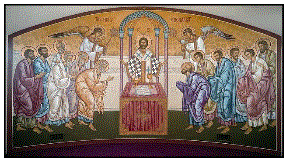 In the last issue of this article I began sharing thought about the birth of Icongraphy. Sometimes the sacraments of baptism and the Eucharist were depicted but usually in a rather allusive manner. Certain scenes from the Old and New Testaments were found: Jonah and the whale, Daniel in the lion’s den, Noah and the ark, Abraham and Isaac, the raising of Lazarus, and the adoration of the Magi. The latter was shorthand for the whole of the incarnation and redemption, and counterbalanced the representation of Adam and Eve, standing for the state of sin from which we need deliverance. Most orf the scenes depict the salvation of individuals in response to their faith and prayer, and correspond to the prayers made for the dead: in the past God has saved these individuals, may he now save those who have died. Other images are less easy to interpret. There recurs the conventional image of the mother and child. But it is not clear whether this always represents Mary and the child Jesus.
In the last issue of this article I began sharing thought about the birth of Icongraphy. Sometimes the sacraments of baptism and the Eucharist were depicted but usually in a rather allusive manner. Certain scenes from the Old and New Testaments were found: Jonah and the whale, Daniel in the lion’s den, Noah and the ark, Abraham and Isaac, the raising of Lazarus, and the adoration of the Magi. The latter was shorthand for the whole of the incarnation and redemption, and counterbalanced the representation of Adam and Eve, standing for the state of sin from which we need deliverance. Most orf the scenes depict the salvation of individuals in response to their faith and prayer, and correspond to the prayers made for the dead: in the past God has saved these individuals, may he now save those who have died. Other images are less easy to interpret. There recurs the conventional image of the mother and child. But it is not clear whether this always represents Mary and the child Jesus.
The iconography of the catacombs arose in a liturgical setting, that of prayer for the dead. The frescoes at Dura also relate to the liturgy, this time of baptism. Behind the font, which is placed beneath an arched canopy, are Adam and Eve, and, much larger, the Good Shepherd and his flock. They symbolize original sin and the redemption wrought by Christ. The surviving frescoes include the Samaritan woman at the well, Christ walking on the water, the raising of Lazarus, and the resurrection of Christ, shown by means of the three women at the tomb. The healing of the paralytic is there, and so is David’s victory over Goliath. These all point to the victory over evil and the new life and health which baptism confers.
There are no instances known from the third century of Christian decoration of the eucharistic hall. But the images found in the catacombs and at Dura make it clear that the iconography which was later to play so important a part in the decoration of Christian churches, especially in the Byzantine tradition, had its roots in the Hellenistic art of the third century, adapted to express fundamental Christian themes.
One other aspect of late classical art was to become a great importance in the Eastern Christian tradition, both in private devotion and in corporate worship, and that was portraiture. It is quite probably that Christians began painting portraits of distinguished and venerated members very early on.
